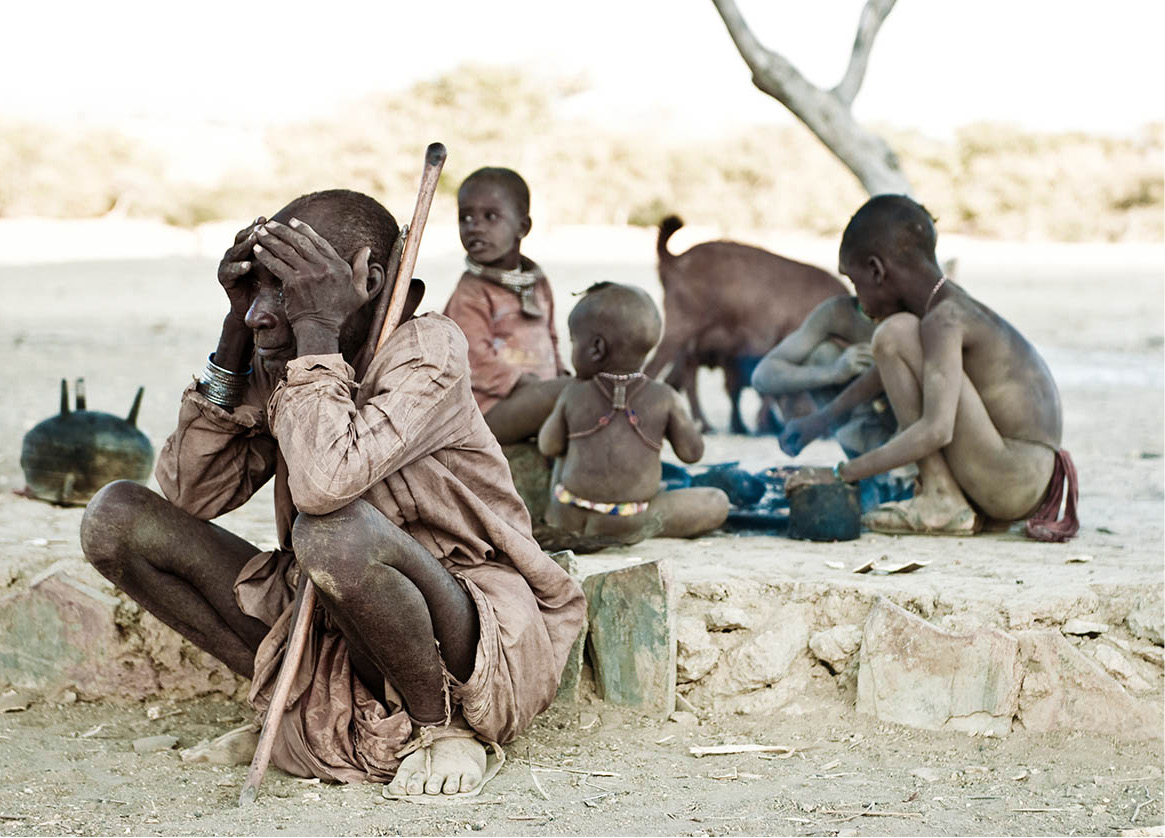Scientists now agree with some confidence that Africa was the cradle of mankind. All the available palaeontological evidence indicates that the first humans evolved on the African continent, that, before migrating northwards into Europe and Asia. Taxonomists place these early humans in the subfamily Hominini, which all members of the human clade (including modern Homo sapiens) subsequent to the evolutionary split from chimpanzees.

A Himba man standing outside his hut.
Clare Louise Thomas/Apa Publications
Hominine taxonomy is a matter of considerable controversy, with experts frequently disagreeing on the status and significance of any given fossil, and theories are regularly revised as new discoveries come to light. Broadly speaking, however, the oldest genus of hominid is Ardipithecus, which first showed up on the fossil record some 5.6 million years ago and is thus far known only from the Ethiopian Rift Valley. Ardipithecus was possibly ancestral to Australopithecus (literally “Southern Ape”), several species of which are recognised, and which roamed widely throughout sub-Saharan Africa between 4 and 1.7 million years ago.

The White Lady rock painting near Brandberg.
Clare Louise Thomas/Apa Publications
Opinion differs as to whether Australopithecines were ancestral to the genus Homo, which emerged some 2.5 million years ago. However, the cranially enlarged Australopithecus garhi, first discovered in Ethiopia in 1996, is regarded by advocates of this theory as the missing link between the two genera. Fossil evidence suggests that the two genera co-existed in Namibia and elsewhere in southern Africa for at least half a million years before Australopithecus became extinct.
Relics of early man
Remnants of our own direct ancestor, Homo sapiens, have been found widely distributed throughout southern Africa. African variants of Homo sapiens display genetic markers that are called Negroid – as opposed to the Mongoloid and Caucasoid variants found elsewhere. Crudely stated, this implies that black people have been living in southern Africa for about 100,000 years.
Otjiseva Man
In 1991, a US-French team of palaeontologists led by Glenn Conroy and Martin Pickford made a thrilling discovery at Berg Aukas in the Otavi Mountains to the north of Windhoek. The scientists found the fossilised jawbone of an anthropoid from the Middle Miocene period, dating back 13 million years. This was the first discovery of its kind south of Kenya, and it was named Otavipithecus namibiensis or Otjiseva Man. Now preserved in the National Earth Science Museum in Windhoek, it predated the earliest known Australopithecus fossils by 8 million years, and is placed in the “super-family” that includes gibbons, apes and humans.
Within the Negroid genetic constellation, however, different groups developed in relative isolation from each other. One sub-group which we particularly need to notice must have lived in relative isolation in the southwestern corner of the continent for about 40,000 years. These were the so-called Khoisan peoples, who once inhabited substantial parts of what is now Namibia, South Africa and Botswana.
The hunter-gatherer peoples that populated Southern Africa were once designated with blanket terms such as Bushmen or San. Since 1996, however, the relevant groups in Namibia have agreed to be described collectively as San.
Hand axes, cleavers, pebble choppers and other tools dating from the Early and Middle Stone Age (between 27,000 and 25,000 years ago) have been found at sites throughout the territory – even in the heart of the Namib Desert, which indicate that major climatic changes must have occurred there in the not-too-distant past. Most of the relics have been found along seasonal riverbeds and coastline, and around natural springs. One interesting find was in present-day Windhoek, which tells us that these Early and Middle Stone Age people were hunting elephant and other big game in what is now the heart of the capital.
It’s estimated that small bands of these hunter-gatherers wandered from one hunting ground to another, following the seasonal migrations of game. Painted and engraved stone slabs depicting their domestic life and religious rites have been found in abundance all over Namibia – most significantly in Damaraland, and in the Huns mountains to the south of the country.
The Khoisan were shorter and had lighter-coloured skin than most other Africans, their language contained clicking sounds and other unusual consonants, and they knew nothing of agriculture or iron-working.

Daily life in a Himba village
Clare Louise Thomas/Apa Publications
Then, about 2,600 years ago, one group of Khoisan living in northern Botswana were initiated into cattle-keeping by other Africans. Being herders rather than hunters, they multiplied and dispersed very rapidly. They called themselves Khoikhoi – “men of men” – or Nama people, and they called the remaining hunter-gatherers San.

Dunes near Sesriem.
Clare Louise Thomas/Apa Publications
Migrations from the north
By the beginning of the 9th century, groups of Bantu-speaking people from central Africa started migrating into Namibia. Taller, darker-skinned and more technologically sophisticated than the Khoisan-speaking peoples, they spoke languages that indicate their cultural links with the rest of sub-Saharan Africa. Internationally, these are known as ‘Bantu’ languages, a term so abused by the South African administration in Namibia during apartheid times that it is no longer socially acceptable there, in any context. Settling in the northeast (present-day Caprivi and Kavango regions), the north-central (Ovamboland) and the northwest (Kaokoland), these Africans brought with them pastoral practices as well as pottery and metal-working skills – but as they moved in, the indigenous San groupings were pushed steadily southwards.
The apartheid picture
Yet a very different picture of the origins of Namibia’s peoples was painted during South Africa’s long occupation of Namibia in the 20th century. Apartheid theorists were fond of describing the southwestern corner of the African continent as an empty land, peopled solely by immigrants. Apartheid maps showed fat black arrows depicting waves of Africans migrating into the region from the far north, while much thinner white arrows discreetly indicated the European incursions from the south. The intention, of course, was to give the impression that Namibians both white and black, equally, were intruders of alien origin, and that the white minority had the same moral right to the land as the black majority.
For similar reasons, apartheid theorists went to great lengths to emphasise what they saw as the cultural differences between different kinds of Africans. Black Africans were alleged to belong to “tribes” that were culturally monolithic and mutually incompatible. These could not be trusted to live in peace, and had to be sharply segregated from each other. Apartheid theory also sought to disaggregate this African majority into much smaller components so that the white minority no longer seemed like a white minority, but more like one tribe among many other tribes.
Such theories are rarely met within Namibia today, but unfortunately the underlying stereotypes still persist to a surprising degree.